Bugatti Tourbillon V16 Hybrid Hypercar Is Designed To Still Be Timeless Next Century
Twenty years after the game-changing Bugatti Veyron entered production and eight years after the Chiron was unveiled, it’s time for a new Bugatti, and the French brand’s latest hypercar is unlike anything that’s come before it. Enter the Bugatti Tourbillon. Powered by a new V16 plug-in-hybrid powertrain, built on a new structure and featuring a spectacular design inside and out, Bugatti’s goal for the Tourbillon is for it to remain timeless “for all eternity.”
CEO Mate Rimac says Ettore Bugatti’s sentiments of “if comparable it is no longer Bugatti” and “nothing is too beautiful” were his main guiding paths for the new model, the first one developed under the Bugatti-Rimac venture that was established in 2021. Three iconic Bugattis were chosen as inspiration: The Type 57SC Atlantic, the Type 35, and the Type 41 Royale. The new car needed to feature design and engineering techniques that would ensure the car will look at home on concours lawns into the next centuries, as modern technology can get dated fast.
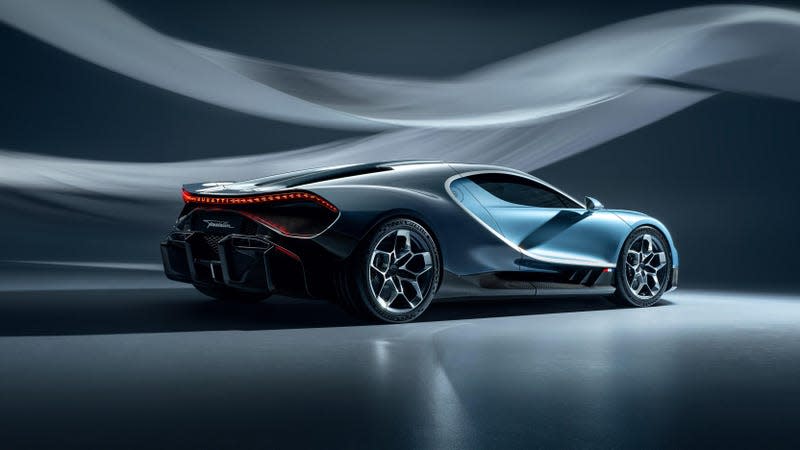
Thus the name: Tourbillon is a type of watchmaking invented by Swiss-French genius Abraham-Louis Breguet in which the balance wheel and escapement are mounted in a rotating cage to counteract gravity and increase accuracy in their timekeeping. Such mechanisms are still the pinnacle of watchmaking, says Bugatti, and the Tourbillon certainly seems like the pinnacle of the automotive realm — Rimac calls it “more elegant, more emotive and more luxurious than anything before it. Quite simply, incomparable.” It helps that the car has a number of watch-inspired design elements, too.
Not just a reworked Chiron, the Tourbillon is built off a completely new chassis and structure made from next-generation T800 carbon composite. Its front and rear frames use 3D-printed braces and low-pressure thin-wall aluminum casting, and the hollow arm of the rear wing is AI-developed and also 3D-printed. Where the Chiron had steel double-wishbone suspension, the Tourbillion has an aluminum multi-link setup that has “organic-designed” arms and uprights that were 3D-printed from aluminum, a 45-percent weight savings versus the Chiron.
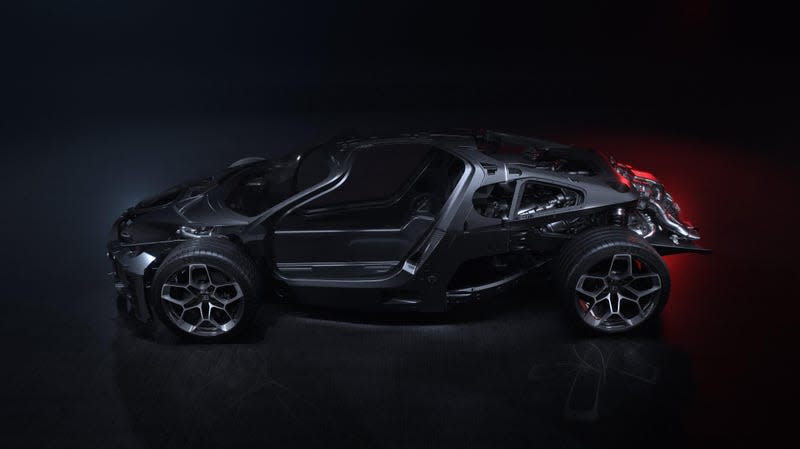
Bugatti calls the Tourbillon’s powertrain a “masterpiece of internal combustion engineering,” and it certainly seems like a suitable replacement for the groundbreaking W16. It all starts with a naturally aspirated 8.3-liter V16 that was developed with Cosworth’s assistance. On its own the engine makes 1,000 horsepower and 664 pound-feet of torque, and it revs to a 9,000-rpm redline, nearly 2,000 rpm higher than the Chiron Super Sport. The engine weighs just 556 pounds, nearly half as much as the Chiron’s quad-turbo W16.
Integrated as a structural part of the monocoque is the oil-cooled 24.8-kWh 800-volt battery pack, which is mounted in the central tunnel and behind the passengers. An e-axle at front houses two electric motors and there’s a third electric motor at the rear axle; all have an integrated dual silicon-carbide inverter and are able to spin at up to 24,000 rpm. Bugatti says the Tourbillon’s electric powertrain is one of the most power-dense in the world, and the motors make a total 800 hp. This setup gives the Tourbillon all-wheel drive and totally variable torque vectoring, and it also provides an electric range of over 37 miles, far greater than any other plug-in-hybrid supercar.
Total output is 1,800 horsepower, more than any other modern Bugatti. A longitudinal 8-speed dual-clutch transmission The company says it will hit 62 mph in 2 seconds flat, reach 124 mph in under 5 seconds and hit 186 mph in less than 10 seconds. Reaching 248 mph from a stop requires fewer than 25 seconds. Normally the Tourbillon’s top speed is 236 mph, but use the Speed Key and that raises to 276 mph, 12 mph faster than the standard Chiron and 3 mph more than the non-300+ versions of the Chiron Super Sport. Bugatti has previously said it’s done chasing top speed records after being the first company to hit 300 mph, but it’s at least nice to see that it’s not done making its new cars faster than the last. The whole thing sounds incredible too, as you can hear in the above video.
The carbon-ceramic brakes are new too, with a bespoke brake-by-wire system that was developed by Bugatti and “blends seamlessly through an integrated vehicle non-linear controller.” Bugatti still uses normal five-lug wheels instead of center-lock units like many other supercars, wrapped with Michelin Pilot Cup Sport 2 tires sized 285/35R20 up front and 345/30R21 at the rear.
That V16 is quite huge — the crankshaft is a meter long — so it’s no surprise the Tourbillon is bigger than the Chiron. At 183.9 inches long it’s 5 inches longer than its predecessor, and the Tourbillon’s 107.9-inch wheelbase is stretched by 1.2 inches. The Tourbillon is about an inch lower to the ground, too. Despite the V16 and the heft added by the hybrid system Bugatti says the Tourbillon is lighter than the Chiron thanks to its construction and other weight-savings measures.
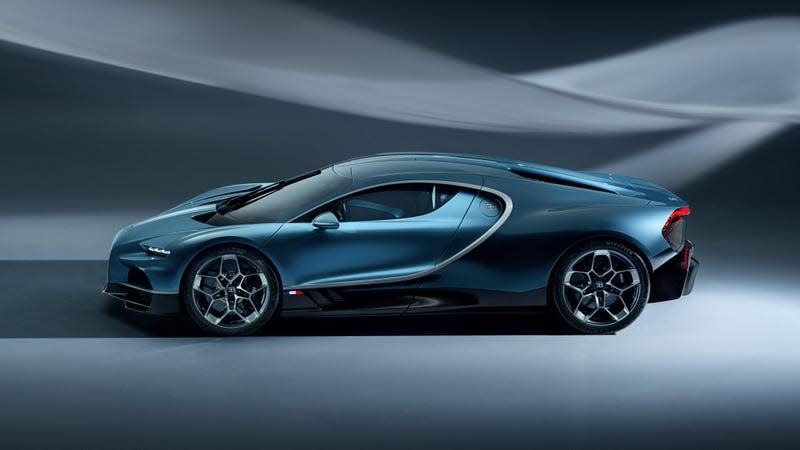
The Tourbillon’s styling is a natural evolution of what we’ve seen from Bugattis like La Voiture Noire, the Mistral and the never-produced Atlantic coupe concept — and I think it’s quite spectacular. Its wedge-shaped proportions are even more dramatic, its details even more intricate. Bugatti says there are four main design elements that make up its modern cars: the central ridge down the middle of the car, the C-shaped Bugatti Line on the sides, the split dual-color scheme, and the horseshoe grille. All are present, and all are more exaggerated than what we’ve seen before.
Everything about the design was dictated by the aerodynamics required to reach past 250 mph and the thermodynamics required to cool the V16 and hybrid system. Bugatti says the Tourbillon’s shape was inspired by falcons — the fastest animals on Earth (though still not as fast as a Bugatti — most notably in its teardrop profile and lower and wider frontal area. The Tourbillon’s nose is also inspired by Jean Bugatti’s Surbaissé method, which put the engine behind the front axle, allowing for the Type 57SC Atlantic to have a lower nose and thus a higher top speed.
Bugatti says that all of the Tourbillon’s lines originate from the horseshoe grille, which is larger and wider than even the Mistral’s. It’s flanked by giant air intakes that appear swept-back from the prominent nose in profile, with central bars that form the start of the Bugatti Line.
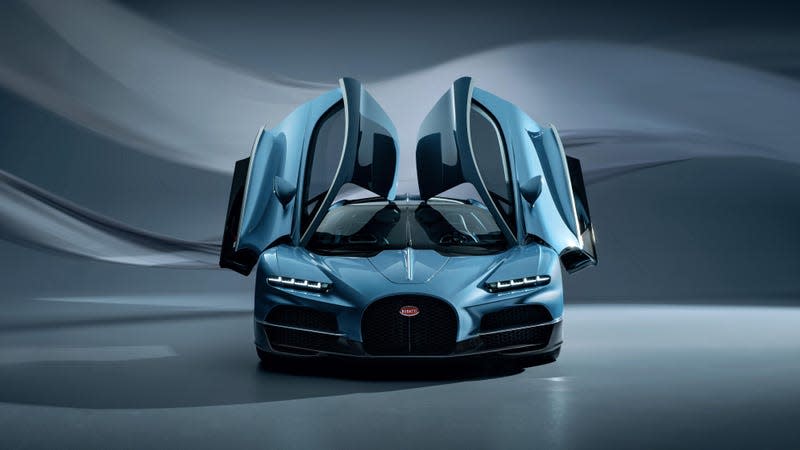
“Flying fenders” appear freestanding from the hood itself, sitting atop super-thin four-element LED headlights that have air channels underneath them. The hood’s intakes are bigger than the Chiron’s, and an “ultra-efficient” cooling system directs air through and out of the hood. All of the front e-axle’s components fit within the same packaging space as the Chiron, and Bugatti was able to give the Tourbillon a larger luggage compartment that, of course, features bespoke fitted luggage.
Where the Veyron’s Bugatti Line was “leaned back” and the Chiron’s “horizontal,” Bugatti describes the Tourbillon’s C-Line as being “wedged forward,” coming to more of a point than its predecessors with a much more dramatic rake. It’s nice to see that the side intakes haven’t really grown, though the Tourbillon has a much more prominent coke-bottle shape with large rear fenders that are really nicely sculpted. The carbon-fiber side skirts have gill-like vanes, with a subtle French flag at the leading edge.
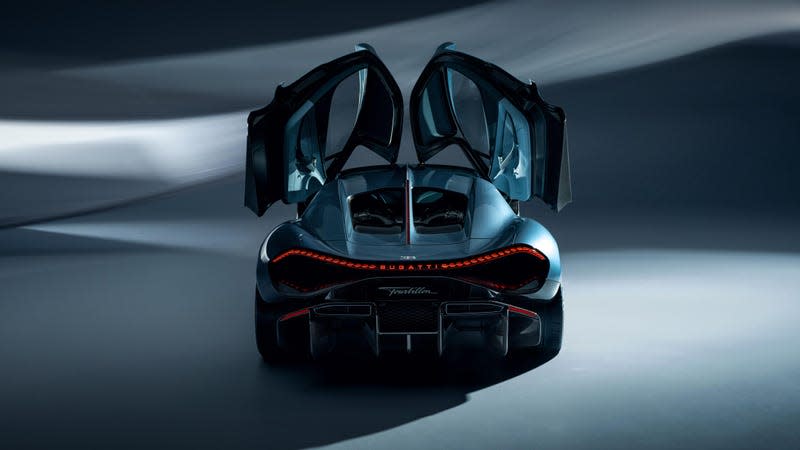
A thin taillight strip with 3D elements and an illuminated Bugatti script follows the contour of the rear end, which has absolutely massive intakes and a shape like an infinity sign. The underbody diffuser starts rising from just behind the passengers, and because of the engine’s V configuration the diffuser’s channels are able to sweep around the engine. The diffuser also functions as part of the crash structure, with the vertical strakes negating the need for a metal crash beam in the bumper, and there’s a thin, wide trapezoidal exhaust tip on each side. Similar to the Lamborghini Revuelto, the diffuser allows for much of the rear tires to be exposed, helping emphasize the car’s width. Unlike the Tourbillon’s predecessors, its active rear wing remains flush in top-speed mode, instead deploying to give more downforce at lower speeds and acting as an airbrake to improve stability when braking.
As with the Veyron and Chiron the Tourbillon’s engine bay is exposed to the elements, and the engine is presented as being even more integral with the car’s body. There are four stunning carbon-fiber mounts that flow into the engine bay surround, and the central spine now features a long CHMSL brake light. Speaking of the spine, which is more pronounced than on the Chiron, it’s echoed by a single windshield wiper that sits in the center of the windshield when it’s not in use.

Open the Tourbillon’s electrically actuated butterfly doors — a first for Bugatti, and they can be opened from the key fob — and you’re greeted by an interior that’s also evolutionary in overall design but has a number of radical elements. Driver and passenger are cocooned in their own teardrop-shaped zones, with an illuminated central spine running from the peak of the windshield, down the bulkhead and forming the thin center console. The dual-color split is really well done, wrapping around the occupants with plenty of contrasting stitching and other accents. I especially love the woven leather on the seats and door panels.
Bugatti muses that Tourbillon watches from 100 years ago are still able to be worn and used today, seamlessly fitting in with modern fashion, and it took the same approach for the Tourbillon’s controls. That philosophy is most obvious in the absurdly complex analog gauge cluster, which is built with the help of Swiss watchmakers. The center dial features the speedometer (which goes to 550 kph) on the outside rim and the tachometer inside of it; the right dial shows how much power you’re using from both the engine and the hybrid system; and three small dials to the left show battery charge, fuel level, and oil and coolant temperature.
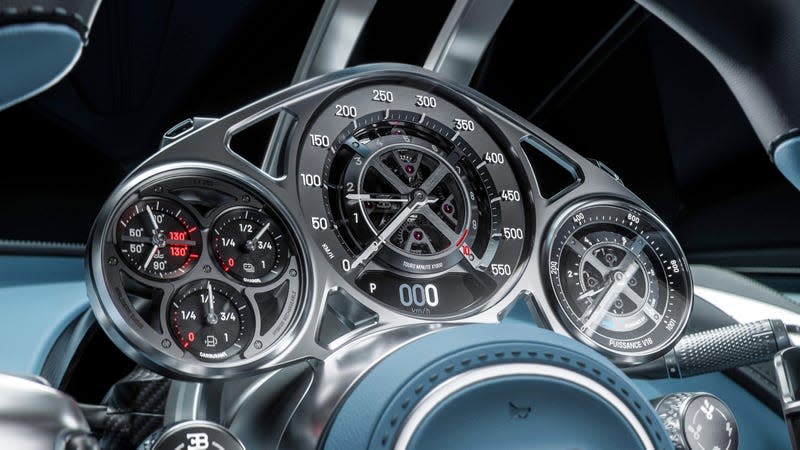
Constructed using more than 600 parts, the “skeletonized” gauges are made from titanium and feature gemstones like rubies and sapphires. All of the internals are visible through the gauge faces, which looks incredible in motion. Bugatti says the largest tolerance is 50 microns while the smallest is only 5 microns, and the whole thing weighs just 700 grams. The gauges are fixed to the central hub of the steering wheel, which itself is fixed, meaning only the rim of the wheel rotates around when turning. If you own an old Citroën C4, you can now say your car is just like a Bugatti. The rim has thumb controls for media and other infotainment functions, while the hub has a pair of knobs for drive modes and hybrid settings — no more buttons shared with a Volkswagen!
Another touch inspired by high-end watches is the center console and dashboard, which uses a mix of aluminum and crystal glass. The aluminum parts are milled from a single block of metal and anodized, and the glass was developed over 13 stages to make sure it stays perfectly clear and is safe in case of an accident. There are two large knobs at the top that each have a display in the center and control the climate control and volume, a few toggle switches that appear freestanding in the open console, and a small glass toggle shifter.
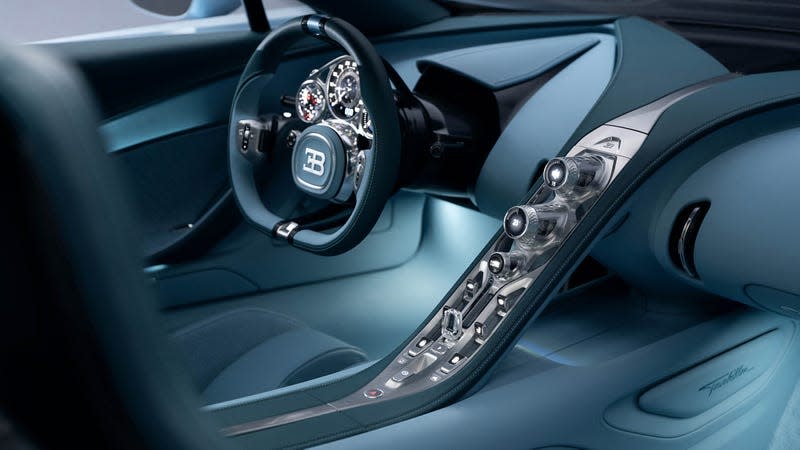
A traditional start/stop button would’ve been too normal, so the Tourbillon has a lever that you pull to start and push to turn off, a “physical experience” that Bugatti says is “a nod to the rituals of historic automobiles.” You can see the inner workings of many of the controls, just like the gauge cluster. Each door has an aluminum knob at the front of the grab handle that controls things like the seats and mirrors, with a button on top for locking and unlocking, but the actual door opening switches are in the center console. There’s also a panel on the roof that has additional switches.
Displays in the control knobs and the small digital speedo readout aside, the only screen in the interior is hidden away until it’s needed by the driver. The small touchscreen deploys from the top of the center console and can be presented in either portrait or landscape mode; it takes two seconds to emerge for the backup camera, and five seconds for the full landscape setup. Apple CarPlay is available, and the screen can show vehicle data and other functions.
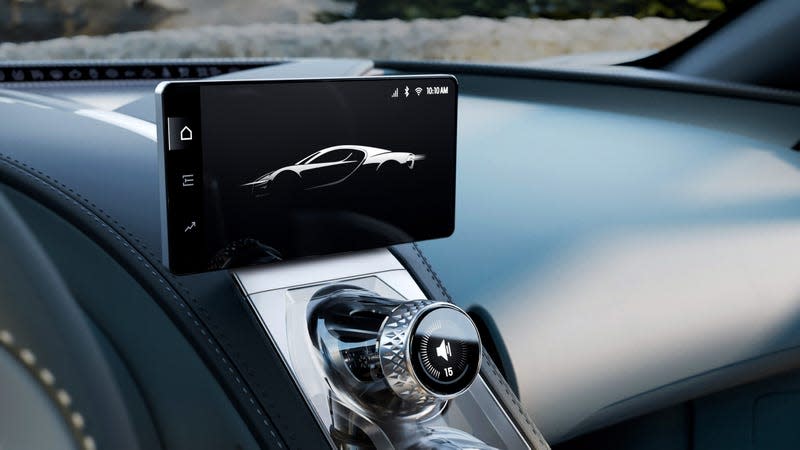
The seats are fixed to the floor, which Bugatti says lets them be as light as possible and mounted as low as possible, with the pedal box being electrically adjustable. Don’t worry, the company promises no compromises were made in terms of comfort. Instead of a traditional audio system with regular speakers and woofers, the Tourbillon has exciters mounted in interior panels like the door cards, which is a lighter and more efficient solution.
I think the below press release quotes from Maté Rimac sum up why I’m so excited to have him at the helm of Bugatti. He just gets it, he understands the history of the brand and why the cars are so revered today, while never losing the desire for innovation that Rimac has come to be known for. Said Rimac:
We look back through Bugatti history at the creations of Ettore and Jean and you can immediately see that they refused to compromise. The amount of patents Ettore had to his name was incredible, because he didn’t ever want the simplest solution, he always wanted the best solution, even if it didn’t exist yet. He’d go away and he’d build it, test it and refine it until it was perfect. And then he’d make it beautiful. It is why the cars are so revered today, and it is the driving force behind everything we have done with Tourbillon.
“So yes, it is crazy to build a new V16 engine, to integrate with a new battery pack and electric motors and to have a real Swiss-made watchmaker instrument cluster and 3D- printed suspension parts and a Crystal Glass center console. But it is what Ettore would have done, and it is what makes a Bugatti incomparable and timeless. Without that kind of ambition, you might create a great hyper sports car, but you wouldn’t create an icon Pour l’éternité’.
While 450 Veyrons and 500 Chirons were produced, only 250 units of the Tourbillon will be built. It’ll start at €3.8 million, the equivalent of just over $4 million — not that much more than the Chiron, which originally started at $3 million. Customer deliveries will commence at some point in 2026 after production of the Bolide and Mistral has finished, and the Tourbillon will be hand-assembled at the Bugatti Atelier in Molsheim, France.
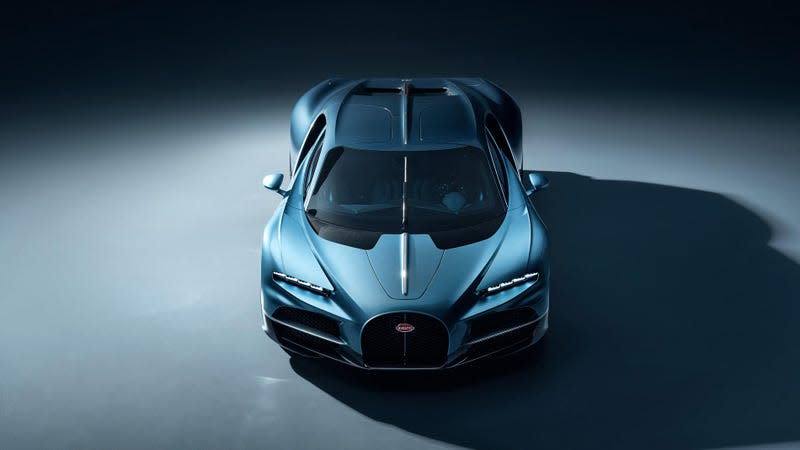
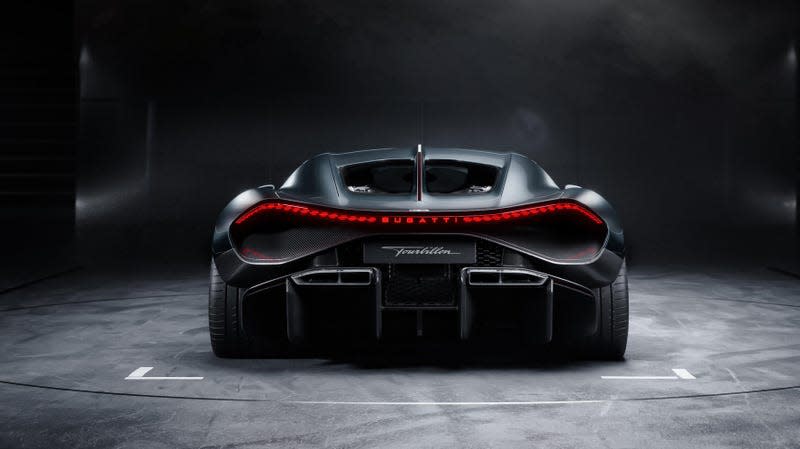
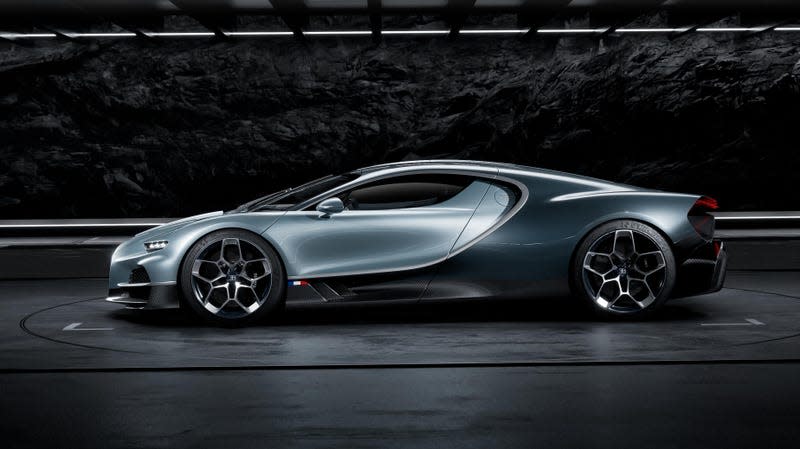
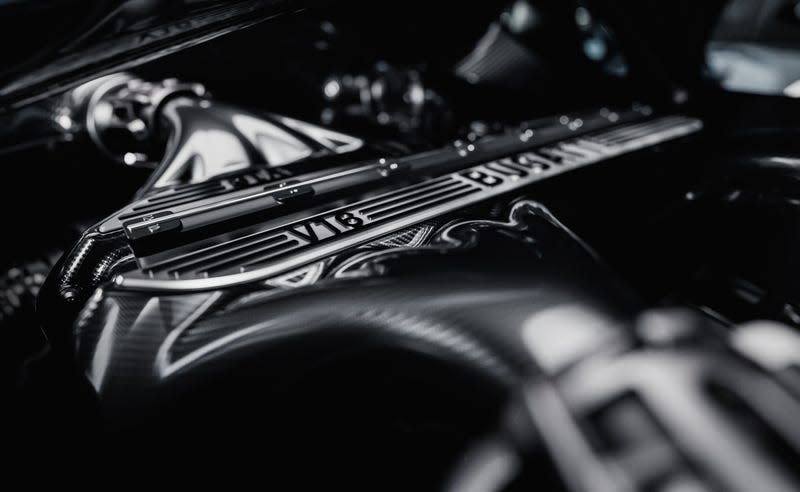
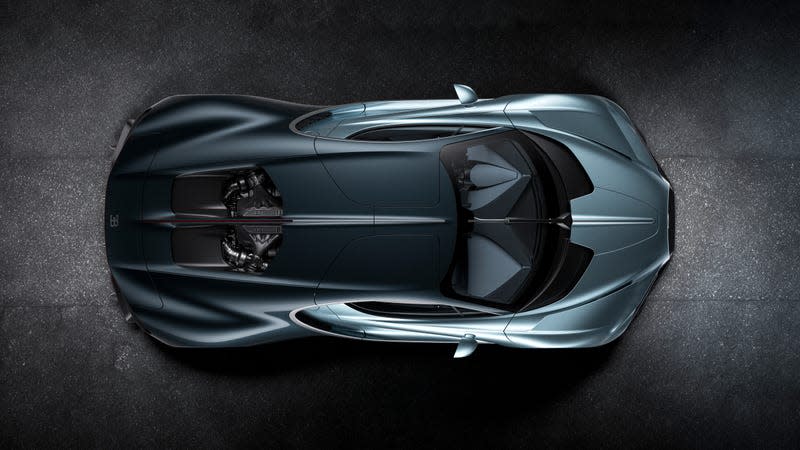
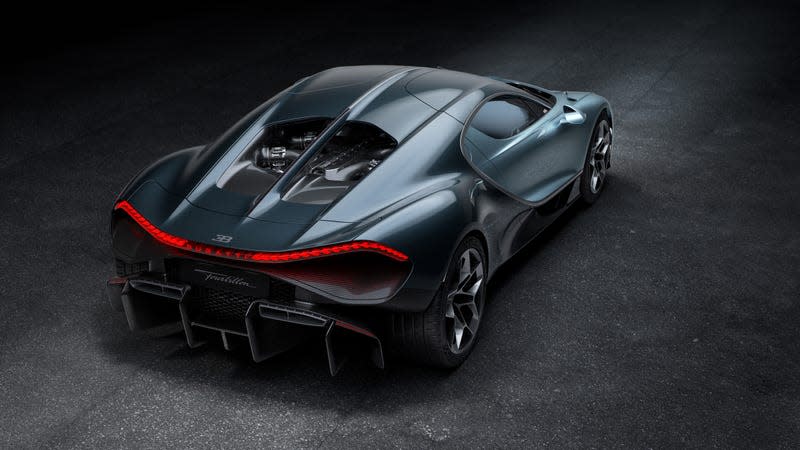
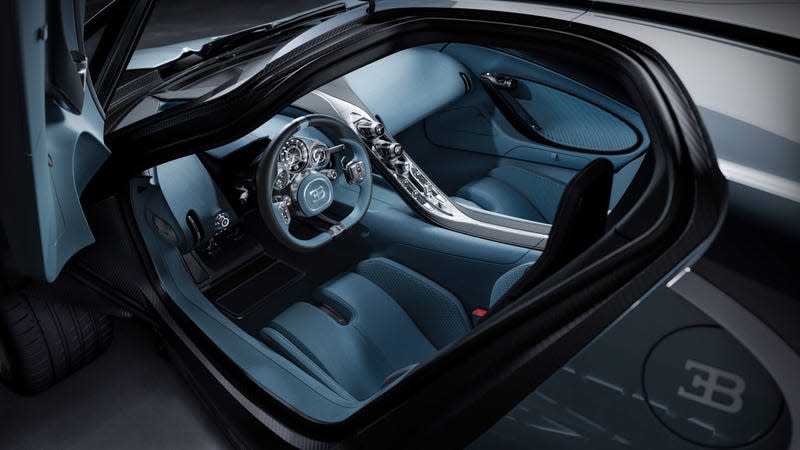
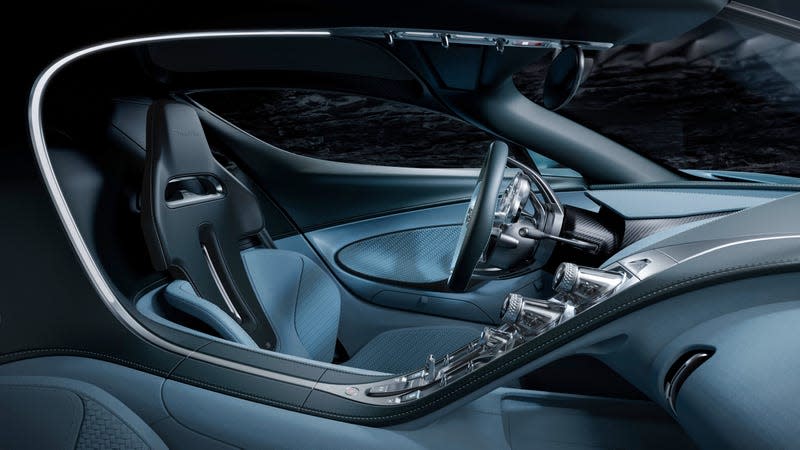

 Yahoo Autos
Yahoo Autos 